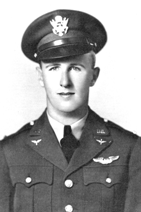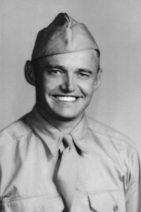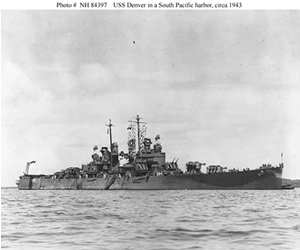Brightwood Boys, The History of the Men from
the North End of
Springfield, Massachusetts,
During World War II
by Christopher P. Montagna
CHAPTER 11
A HERO GONE
 Back in Springfield, Thomas Cavanaugh, an eight-year-old boy living in the apartment complex at 1716 Dwight Street marveled at the presence of First Lt. Donald Weaver. Donald was the only son of Clarence and Ruth Weaver who lived in the apartment next to Tom and his family. Donald was a 1932 graduate of Classical High School who went on to earn a degree in engineering from Massachusetts State College (now the University of Massachusetts). Upon his return to Springfield, the nation was in the depths of the Great Depression, which hindered his career as an engineer. In order to make ends meet and help support himself and his parents, Donald took a job driving a milk truck.
Back in Springfield, Thomas Cavanaugh, an eight-year-old boy living in the apartment complex at 1716 Dwight Street marveled at the presence of First Lt. Donald Weaver. Donald was the only son of Clarence and Ruth Weaver who lived in the apartment next to Tom and his family. Donald was a 1932 graduate of Classical High School who went on to earn a degree in engineering from Massachusetts State College (now the University of Massachusetts). Upon his return to Springfield, the nation was in the depths of the Great Depression, which hindered his career as an engineer. In order to make ends meet and help support himself and his parents, Donald took a job driving a milk truck.
Donald began taking flight courses at Springfield College and eventually learned to fly at the Springfield Airport as part of the Civil Aeronautics Administration (CAA) program. On February 10, 1941, Donald Weaver entered the military as an aviation cadet with the Army Air Corps and trained at the Army Flying Field in Albany, Georgia. On September 26, 1941, Donald Weaver earned his wings and commission as a 2nd Lt. in the Army Air Corps. On the following day, September 27, 1942, Donald returned and married Janet Waterbury of Agawam. After being stationed at bases across the United States, Donald was sent to the ETO in June of 1942. Donald was promoted to 1st Lt in July of 1942 and assigned to the 345th Fighter Squadron in North Africa.
In January of 1943 Thomas Cavanaugh was home sick from school when word was received at the Weaver home that First Lt. Donald Weaver was killed in action on January 18, 1943. Lt. Weaver’s fatal flight is recorded in the unit history of the 345th Fighter Squadron:
Weaver was killed while on a practice gunnery flight, within a couple of weeks after arriving in North Africa. The ‘dry’ lake on the edge of Oran picked up some water in the rainy season, which included January. Could have been dry or may have had some water at the time, if the latter, it would be even more difficult to judge height. However, none of us had much experience or practice making strafing passes at that point in the war. We had at least one more pilot crash into the sea, a 347 sq pilot, Rose, off Taher, Algeria, in the spring/summer of 43 while firing at a rock that stuck up above the sea, designated as the Squadron’s practice strafing target. And, a number of pilots ran into the ground on strafing runs in combat operations.
Donald Weaver left behind his wife Janet and a 2 and ½ month old daughter, Susan.
A few weeks into the New Year, another Brightwood Boy joined the newly formed Army Air Forces. Bernard “Bert” Sitek, the son of Joseph and Mary Sitek was living at 7 Greenwich Street when he was inducted into the Army on January 20, 1943. His civilian occupation as a milling machine operator at the Van Norman Company found him serving as an airplane sheet metal worker at Chanute Field in Illinois. Bert also trained in telephone and telegraph repair at Camp Crowder in Missouri.
The sacrifice of families continued as more men took up the fight. On February 25, 1943 Raymond Dupre, the twin brother to Roland Dupre, who was killed in the Battle of Savo Island, enlisted in the Army. Prior to joining the Army Raymond Dupre, like his brother, was employed as a binderman at the Phelps Publishing Company.
 Also enlisting in the service was Alexander Samol, the eldest of three sons born to Russian immigrants. Alexander Samol grew-up on Hebron Street and served a time with the Civilian Conservation Corps. At the time of his enlistment, thirty-year old he was married to Alice (Farmer) Samol and living at 21 Jenks Street. Alexander’s brothers Michael Samol and Louis Samol were also in the service as members of the Navy.
Also enlisting in the service was Alexander Samol, the eldest of three sons born to Russian immigrants. Alexander Samol grew-up on Hebron Street and served a time with the Civilian Conservation Corps. At the time of his enlistment, thirty-year old he was married to Alice (Farmer) Samol and living at 21 Jenks Street. Alexander’s brothers Michael Samol and Louis Samol were also in the service as members of the Navy.
Alexander Samol was inducted in the Army on June 21, 1943. After basic training he was assigned as a rifleman with company B of the 550th Infantry Airborne Battalion. The 550th Infantry Airborne Battalion was designated as a Glider Infantry Regiment (GIR).
 The Glider Infantry Regiments were composed of men who were inducted into the service, versus paratroopers who were all volunteers. The troopers rode in a Waco glider that was described as, “nothing but plywood, canvas and tubes”. Landings were a hair raising experience. Glider troops rode all the way into the landing zone in the glider. The landing was usually a modified semi-controlled crash.
The Glider Infantry Regiments were composed of men who were inducted into the service, versus paratroopers who were all volunteers. The troopers rode in a Waco glider that was described as, “nothing but plywood, canvas and tubes”. Landings were a hair raising experience. Glider troops rode all the way into the landing zone in the glider. The landing was usually a modified semi-controlled crash.
 After a “shakedown” cruise in the Atlantic Ocean to test the performance of the ship, as well as to familiarize the ship's crew with operation of the craft, the USS Denver was transferred to the Pacific Theater of Operations.
After a “shakedown” cruise in the Atlantic Ocean to test the performance of the ship, as well as to familiarize the ship's crew with operation of the craft, the USS Denver was transferred to the Pacific Theater of Operations.
On March 5, 1943, Earl Diamond was involved in his first battle of the war. The USS Denver was proceeding in company with Comtaskforce 68, consisting of the USS Montpelier, USS Cleveland, USS Conway, USS Cony and USS Waller to Kula Gulf for bombardment of Vila, Kolombangara Island, New Georgia Group. The following is taken from the After Action Report filed by the Commander of the USS Denver:
The ship's company was at battle stations, and ship in Battle Condition. Just after midnight on March 6, radar operators reported getting curious interference effects. The boggies were identified as ships of the Japanese 'Tokyo Express'.
At 1:01 am the Montpelier opened fire to starboard on enemy surface target followed immediately by the USS Cleveland and USS Denver, and then the order to commence firing was received. In the ensuing action, which lasted fifteen minutes, two Japanese ships were sunk by cruiser main battery gunfire and destroyer torpedoes. Shore batteries and surface targets were also engaged by the Taskforce ships.
One man was injured at 20 MM Mount No. 17; man was removed to the main deck battle dressing station and at 0125 pronounced dead by the Medical Officer as a result of blast of turret guns. Identity of man was later established as James William Thompson, S2/c, 560-09-06, V-6, U.S.N.R.
Throughout the early morning hours, the Denver continued to open fire on shore objectives and surface ships. The Japanese lost two destroyers, the Minegumo and Murasame, but the American cruiser USS Helena was sunk by Japanese torpedoes.